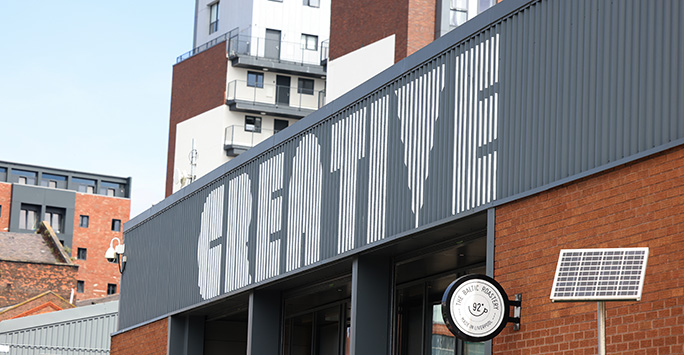Making the case for culture: rethinking how we value the creative industries in Liverpool City Region
Posted on: 11 July 2025 by Martha Cook in Blog

Recent University of Liverpool graduate and current Heseltine Institute intern Martha Cook assesses the place of creative industries in the UK’s industrial strategy and discusses the potential to rethink how we value culture.
In May 2025, the government released its Modern Industrial Strategy, outlining eight key sectors aimed at driving growth. One of these sectors is the creative industries (including film and tv, video games, music and the arts), and alongside the industrial strategy, the Department for Culture, Media and Sport (DCMS) has released its sector plan, emphasising its essential role in driving growth for the UK economy. However, despite this welcome focus on the creative industries in national policy, there is little focus on the broader cultural ecosystem which supports the sector.
The inclusion of creative industries as an ‘IS-8’ sector represents an excellent opportunity for visibility and the potential to attract investment. It is also an opportunity for Liverpool City Region, which hosts several successful global cultural exports, including its two Premier League football clubs, and world-famous heritage and arts assets. The city region is also home to major events, including Eurovision in 2023 and the recent BBC Radio 1 Big Weekend. Since 2019, concerts at Anfield Stadium, hosting the likes of Taylor Swift and Elton John, have boosted the local economy by £31 million, while Eurovision increased tourism in the year after the event by 72,454 trips.
However, the value of the creative industries cannot be measured solely by economic indicators like ticket sales or GVA. A narrow economic focus risks sidelining grassroots organisations and local talent essential for a vibrant cultural ecosystem. Measuring culture only in economic terms can overshadow community initiatives in favour of more profitable events. As the creative industries in Liverpool demonstrate, social value can offer an alternative perspective on measuring the local economic impact of culture and the creative industries.
How do we value culture?
Liverpool is shaped by its creativity, resilience and community identity. From work within creative neighbourhoods to charities like Liverpool Lighthouse and independent galleries like OpenEye and World of Glass, the culture of Liverpool is lived and experienced locally. These smaller initiatives are vital: they root culture in place, contribute to community pride, and shape how people perceive and connect with their city. For example, Liverpool Arab Arts Festival amplifies underrepresented voices and supports cross-cultural understanding. Meanwhile, Liverpool Lighthouse's local events, like the Gospel Music Festival and community workshops at the Shakespeare North Playhouse, offer safe spaces for creativity and mental wellbeing.
By standard economic measures, these events cannot compete with the impact of larger institutions. However, while smaller-scale cultural events and organisations may not show immediate economic return, they can create long-term social impact: supporting mental health, building youth opportunity, fostering inclusive communities, and building a sense of place.
Currently, narrow economic measures, focused on footfall, revenue, and ticket sales, fail to capture these benefits. This means there is a danger of policy losing sight of the importance of grassroots and community creative industries. Alternative frameworks focusing on social value are emerging to bridge this gap. One example is the Cultural Value Indicator, developed by the Centre for Cultural Value, which seeks to redefine success by measuring indicators like formal and informal participation, infrastructure, inclusivity, social impact and long-term economic contribution.
Alternative approaches to measuring value can also help policymakers understand the impact of large events on grassroots and community culture. This was demonstrated by the successful engagement of local communities during Eurovision 2023, which, despite its global appeal, retained a distinctly ‘Liverpool’ feel, creating a sense of pride and belonging. Though many headlines focused on the economic uplift, research from the Heseltine Institute also highlighted how Eurovision contributed to increased civic pride and a stronger sense of connection to community and place. This broader view of value encourages us to rethink how we assess local culture. Measuring the impact of Liverpool Lighthouse, World of Glass or Liverpool Arab Arts Festival in this way, could better capture the value these organisations and events bring.
Can devolution help support Liverpool City Region’s creative industries?
The Modern Industrial Strategy has highlighted creative industries as an important sector, bringing much-needed attention and investment to arts and culture. However, it's uncertain how long this impact will last without supporting culture at the community level. With real-terms cuts to DCMS in the recent spending review, creative industries can't rely on national support. Liverpool City Region has an opportunity through devolution to implement cultural policy that genuinely reflects the value of local communities. Liverpool is well placed to set an example for how regions can economically and socially value culture.
Measuring culture by its social value can help us find worth beyond just economic gains. Instead of focusing on the economic impact of large events, social value can help us understand the importance of community centre youth programs, small galleries, grassroots music venues, and the networks that support them. Without them, we risk a long-term decline in culture, loss of place and identity. If we want to build a sustainable cultural economy, we need to shift our focus from asking what culture can do for GDP to asking what it can do for the people living, working, and creating in these communities.
Image credit: Gareth Jones
Keywords: culture, creative industries, social value.